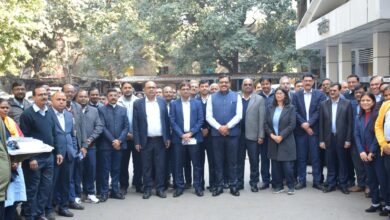By Opting For Drip Irrigation, Cotton Farmers Can Save Water And Reap Profits
By adopting drip irrigation, we can spin a bright future for our cotton farmers, opines C.K. Patel, AGM - Agronomy & Marketing, Netafim India

If we look at the big picture, there is reason to feel proud as India continues to be the largest producer of cotton in the world, with China, the US, Brazil and Pakistan snapping at our heels. The country has brought about a qualitative and quantitative transformation in the production of cotton since Independence. India is also the only country in the world that grows not only the four cultivated species of cotton but also their intra-and-inter-specific hybrids on a commercial scale.
The cotton farmer community of the country produces the widest range of cotton capable of spinning from 20 mm to 32 mm staple length counts. Government policies such as giving greater thrust to Research and Development in cotton, encouraging the use of quality seeds and pesticides by providing subsidies for such inputs and price support measures have also contributed to the changing scenario of cotton farming in India. But the devil is in the details, as they say.

Despite having the largest area under cotton cultivation which is about 41% of the world area under cotton farming and accounting for 26% of the world cotton production, the yield per hectare is still lower than the world average yield. The cotton productivity per hectare in our country is as low as 487 kg, which indicates higher land usage and consequently, lower yields along with scant income for the cotton farmers. What is more, the ever-spiralling cost of labour, persistent adoption of unsustainable agricultural practices, extensive use of fertilizers and pesticides as well as genetic modification has posed a significant challenge that needs immediate attention. Given that cotton is a water-intensive crop, the cost of production makes farming nearly unviable, especially for the marginal farmers. Is there no way out for our farmers then to boost cultivation and
dominate the cotton export scene? The answer is a resounding ‘yes.
Drip irrigation, the practical solution to Increase cotton yield and lint quality Embracing scientific methods is the way to profitability, say experts quoting experiments both within the country and abroad. More specifically, they point to drip irrigation as an ideal method well-suited for cotton cultivation. It saves water and electricity and cuts down on the amount of fertilizer required. Drip irrigation supplies water to the cotton crop root and not to the canopy. Thus, keeps the humidity level unaffected. This is significant when the first-floor bolls open. Lower the humidity conditions, better is the lint quality. The application of measured water dosage also helps to control and create flexibility to develop mild stress during specific growth periods. This helps cultivating an ideal plant with several bolls.
It has been established that when a farmer opts for micro-irrigation, there is a reduction in pest and crop diseases. Fusarium wilt and Verticullum wilt are the major soil borne diseases affecting the cotton growth area. Accurate Application of Fungicides directly to the root zone, prevents these diseases. The list of advantages does not end there either. It is possible to do drip irrigation at night and even on uneven land. There is a reduced need for weeding and no significant soil damage as a result of salt deposits. In short, farmers need to adopt this smart way instead of simply toiling away without achieving optimum production from their lands.
Myths about drip irrigation
There’s a misunderstanding among some farmers that with time, the drippers get clogged with dirt and salt deposits. However, it does not happen, thanks to the zigzag design of the dripper for water flow. When water travels along this zigzag pattern, a small vortex is formed, preventing dirt from getting accumulated in the dripper and allowing it to flow out. In the BAR Drippers, more vortex is formed, thereby helping them to work unclogged for long periods of time. To prevent salt deposition, acid treatment should be done at regular intervals. If the system is maintained well and cleaned regularly, it will continue to deliver seamless performance.
Fertiliser management with drip irrigation (per acre)
Getting the crop nutrition spot on is essential for maximising cotton yield. Too little nutrition reduces the crops’ yield potential, while too much fertilizer impacts the profitability through increased costs, contamination of Cotton seedlings, and harvest problems. Performing soil analysis once a year is extremely important to diagnose nutrient deficiencies and take corrective actions, under the guidance of a licensed agronomist. While cultivating cotton, it is advisable to apply 5-6 tonnes of good quality, fully decomposed FYM (Farmyard Manure) direct in the furrows for one
acre of agricultural land without sprinkling it. It is also recommended to apply 4 bags of Superphosphate, 5 kg of micronutrients and 5 kg of sulphur granules as a basal dose for one acre of land. It is also recommended to apply 1.0 litre of PSB culture per acre during the monsoon season. Afterwards, during the flower bud, flowering stage and boll development stage, every 15-20 days, 200-250 gm/acre micronutrients (chelated form) need to be provided through drip irrigation. When cotton is of 45 days, it is advisable to sprinkle NAA at a 40 PPM rate. Apart from this, depending on the growth of the cotton, adjusting the nitrogen group fertilisers is important. Careful monitoring and management of nutrient levels helps the crop to absorb almost 70% of the fertilizers ensuring higher yield potential and improved quality.
Irrigation management
Cotton crop needs a fixed amount of water every day and we need to calculate the required amount of water and provide exactly that much for optimum results. There are two ways of assessing the water requirement; one is by analysing the average evaporation rate and the other is to measure the root depth and irrigate accordingly. In both, with the help of experts, an irrigation timetable is prepared, according to which the farmer provides the right amount of water.
Effective expansion of cotton crop roots
When a cotton crop reaches its adult stage, its roots would have reached a depth of 100 cm. It has been calculated that the crop derives 40 per cent of its fertiliser and water from the first 25 cm, 30 per cent from the following 25 cm, 20 per cent from the third quarter and 10 per cent from the last 25 percent. This means that the deeper the water and nutrients reach, the utility gets reduced. Therefore, fertiliser and water should be provided to the crop as per the timetable to ensure that the utility increases or the water should be provided up to the depth of the roots.
Conservation measures BT Cotton is immune to many of the pests but the ones capable of sucking continue to wreak havoc. This can be effectively controlled by providing pesticide up to the roots with the help of drip irrigation. Specific kinds of pesticide are administered every 30 days till the crop is ready for harvest. The additional cost of spraying pesticide can be avoided this way.
According to the latest Economic Survey, the overall agricultural yield for 2020 has increased up to 30 per cent and water-saving up to 50 per cent because of micro-irrigation practices. Studies have proved that the adoption of micro-irrigation technique in cotton farming helps reduce input cost and boosts income by increasing the yield. The benefits include an increase in water use efficiency up to 80-90 per cent, about 20 per cent reduction in consumption of electricity per hectare and up to 80 per cent increase in fertiliser use efficiency which translates to significant cost
savings. Controlled application of water and fertiliser has resulted in increasing the productivity of the crops up to 50 per cent along with increase in lint and seed cotton quality.
Views expressed here are those of C.K. Patel, AGM – Agronomy & Marketing, Netafim India




